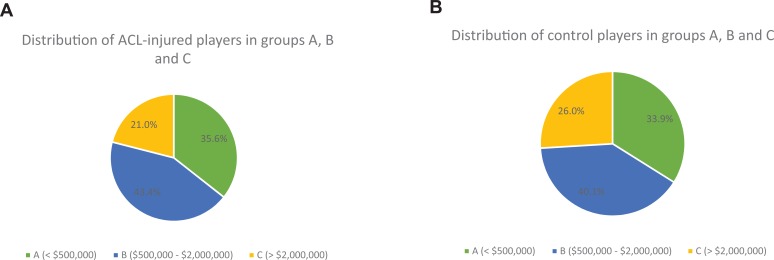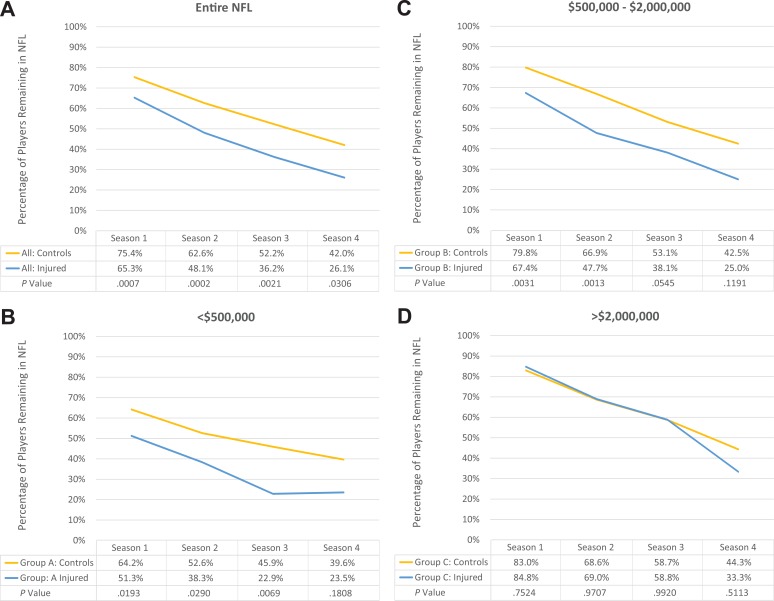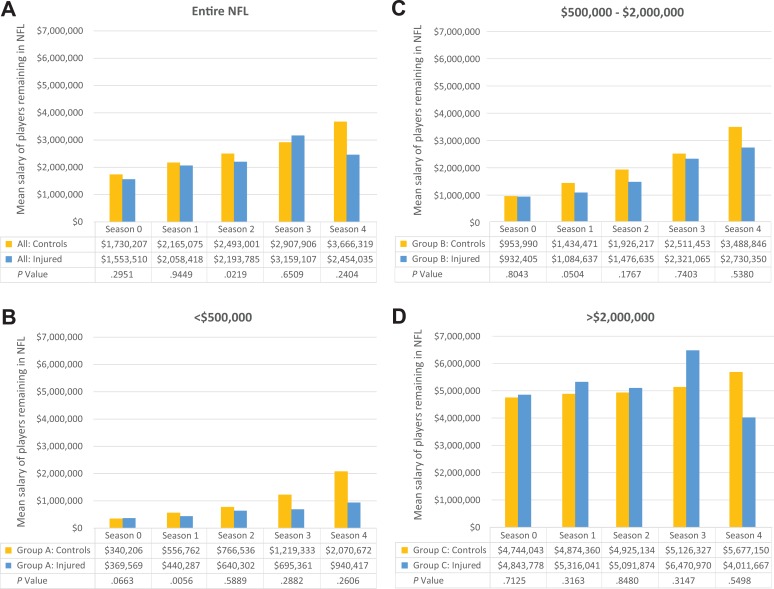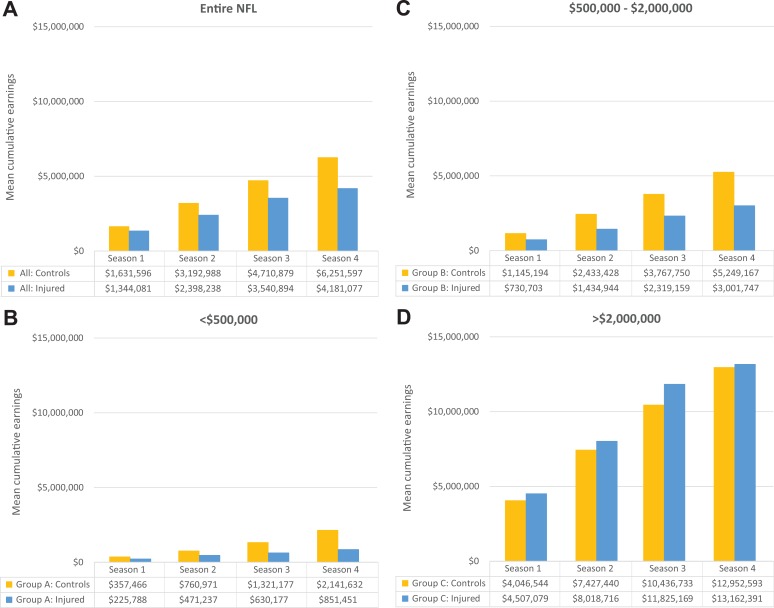Abstract
Background:
Anterior cruciate ligament (ACL) injuries can have negative consequences on the careers of National Football League (NFL) players, however no study has ever analyzed the financial impact of these injuries in this population.
Purpose:
To quantify the impact of ACL injuries on salary and career length in NFL athletes.
Study Design:
Cohort study; Level of evidence, 3.
Methods:
Any player in the NFL suffering an ACL injury from 2010 to 2013 was identified using a comprehensive online search. A database of NFL player salaries was used to conduct a matched cohort analysis comparing ACL-injured players with the rest of the NFL. The main outcomes were the percentage of players remaining in the NFL and mean salary at 1, 2, 3, and 4 years after injury. Cohorts were subdivided based on initial salary: group A, <$500,000; group B, ≤$500,000 to $2,000,000; and group C, >$2,000,000. Mean cumulative earnings were calculated by multiplying the percentage of players remaining in the league by their mean salaries and compounding this each season.
Results:
NFL athletes suffered 219 ACL injuries from 2010 to 2013. The 7504 other player seasons in the NFL during this time were used as controls. Significantly fewer ACL-injured players than controls remained in the NFL at each time point (P < .05). In group A, significantly less ACL-injured players remained in the NFL at 1 to 3 seasons after injury (P < .05), and in group B, significantly less ACL-injured players remained in the NFL at 1 and 2 seasons after injury (P < .05). There was no significant decrease in group C. Players in groups A and B remaining in the NFL also had a lower mean salary than controls (P < .05 in season 1). The mean cumulative earnings over 4 years for ACL-injured players was $2,070,521 less per player than uninjured controls.
Conclusion:
On average, ACL-injured players earned $2,070,521 less than salary-matched controls over the 4 years after injury. Players initially earning less than $2 million per year have lower mean salaries and are less likely to remain in the league than uninjured controls. The careers of players initially earning over $2 million per year, meanwhile, are not negatively affected. This demonstrates the degree of negative impact these injuries have on the careers of NFL players. It also indicates that a player’s standing within the league before injury strongly influences how much an ACL injury will affect his career.
Keywords: ACL injury, American football, economics, professional sports, return to play
All anterior cruciate ligament (ACL) injuries result in negative health consequences. Professional athletes’ livelihoods depend on their ability to perform at the highest level possible, however, and for these individuals, ACL injuries can also have negative financial consequences. This is particularly true for National Football League (NFL) athletes, whose salaries are not fully guaranteed. This means that many players can be cut without long-term financial consequences to their team and raises the possibility of injuries negatively affecting the player’s career in addition to his health. Despite this, very few studies have analyzed the outcomes of ACL injuries in this population. Previous studies have found that 21% to 37% of NFL athletes who tear their ACL never return to play in another NFL game,5,10 and that skilled position players who returned to play performed at a lower level than they did before injury.5 To our knowledge, no study has analyzed the impact of ACL injuries on player salary, and no study has used a control group to compare the return-to-play rates of ACL-injured players with other NFL players.
The purpose of this study was to analyze the financial and professional impact ACL injuries have on NFL players’ careers. We conducted a matched cohort analysis comparing all NFL players who suffered an ACL injury between 2010 and 2013 with the rest of the NFL through the 2014 season, with subgroups matched according to initial salary. Groups were compared according to the percentage of players remaining in the NFL at each follow-up season and the mean salary of those players. Our hypothesis was that ACL injuries would decrease career length and mean salary in all NFL players.
Methods
An online search was conducted to assemble a list of all publicly disclosed ACL injuries occurring in NFL players between 2010 and 2013. A list of ACL injuries from the NFL Injury Surveillance System (NFLISS) was provided by Edgeworth Economics for the years 2004 through 2013. This anonymized list was used as a resource to identify players. No data from the NFLISS were used in our analysis. Searches for “anterior cruciate ligament” and “ACL” were then conducted within NFL.com, ESPN.com, Rotoworld.com, each team’s published media guide, newspapers covering each team, and websites for each team hosted on SBNation.com. Searches for each year as well as the words “NFL” and “ACL” or “anterior cruciate ligament” were also conducted on Google.com. This search was designed to identify all athletes who suffered an ACL injury during the 2010 to 2013 seasons. Only players for which reliable news reports could be obtained confirming the injury were included. All original sources were compiled. These data were used to conduct a previously published epidemiological analysis of ACL injuries in NFL athletes.6
A database of NFL player contracts was constructed using data from Spotrac.com and Overthecap.com. These websites compile databases of publicly reported player contracts and work to independently verify the information. The mean age of players in each group was calculated using player ages from the Spotrac database for uninjured controls and by calculating each player’s age on the date of his ACL injury for ACL-injured players. The player’s salary cap hit was recorded, as this provided the most accurate measure of the player’s value to the team each year. Cohorts were subdivided into 3 groups based on the player’s initial salary (in US dollars ): group A, <$500,000; group B, $500,000 to $2,000,000; and group C, >$2,000,000. These were designed to split the cohort into 3 roughly equivalent-sized groups to analyze the effect of preinjury salary on postinjury outcomes. Players who had suffered an ACL injury during the 2010 to 2013 NFL seasons were compared with the rest of the NFL through the 2014 NFL season. The percentage of players remaining in the NFL and the mean salary of those players was compared at 0, 1, 2, 3, and 4 years after injury between ACL-injured players and the rest of the NFL. Because the injured players and the controls were followed from whenever the reference season occurred until the 2014 season, the cohort shrunk at each time point.
Mean earnings for each group were calculated by multiplying the percentage of each cohort continuing to play in the NFL at each time point by their mean salary and compounding the mean earnings per season. Decreases in earnings associated with ACL injury were calculated by finding the difference between the mean total 4-year earnings of ACL-injured players and the mean total 4-year earnings of the rest of the NFL for each salary-matched group.
The proportion of players remaining in the NFL for the ACL-injured cohort and the controls was compared using a chi-square test for independence. A chi-square test for independence was also used to compare the proportion of players remaining in the NFL between the 3 control groups. Mean salary at baseline and each following season, mean earnings, and age at baseline were compared using a paired 2-tailed t test.
Results
There were 219 ACL injuries in NFL players from 2010 to 2013 and 7504 other NFL players during those seasons who served as controls (Table 1). All players were analyzed from either the year they were injured or the initial season until 2014. The distribution of players within the respective salary groups was similar between the ACL-injured cohort and the rest of the NFL (Figure 1) (P = .249).
TABLE 1.
Number of ACL-Injured Players and Controls in Each Salary Groupa
| Controls | ACL-Injured Players | |
|---|---|---|
| Group A | 2545 | 78 |
| Group B | 3010 | 95 |
| Group C | 1949 | 46 |
| Entire cohort | 7504 | 219 |
aACL, anterior cruciate ligament.
Figure 1.
Percentage of total players in each salary group among (A) anterior cruciate ligament (ACL)–injured players and (B) controls (the rest of the National Football League).
Similar age trends were seen within both the ACL-injured group and uninjured controls at baseline, with players in the lower-earning groups being younger on average (Table 2). None of the differences in age were statistically significant between comparison groups.
TABLE 2.
Mean Age of Each Group at Injury Year for ACL-Injured Groups and at Initial Year of Analysis for Control Groupsa
| Mean Age, y (Controls) | Mean Age, y (ACL Injured) | P Value | |
|---|---|---|---|
| Group A | 23.8 | 24.0 | .257 |
| Group B | 25.7 | 25.7 | .932 |
| Group C | 28.1 | 27.4 | .156 |
| Entire cohort | 25.7 | 25.5 | .255 |
aACL, anterior cruciate ligament.
A significantly lower percentage of total ACL-injured players remained in the NFL at every season after injury as compared with uninjured control players (Figure 2A). The odds ratio for ACL-injured players remaining in the NFL as compared with the rest of the NFL was 0.6152 (P = .0008) in the first year after injury and 0.4869 (P = .0341) at 4 years after injury. Within groups A (Figure 2B) and B (Figure 2C), less ACL-injured players remained in the NFL at all follow-up seasons after injury. This difference was significant in seasons 1, 2, and 3 for group A and in seasons 1 and 2 for group B. The percentage of controls and ACL-injured players within group C who remained in the NFL was nearly identical at 1 to 3 seasons after injury (Figure 2D). The percentages were actually slightly higher in the ACL-injured group at these time points. At 4 years after injury, a greater percentage of group C controls than group C ACL-injured players remained in the league; however, this was not statistically significant.
Figure 2.
Percentage by season of (A) players who remained in the National Football League (NFL) after anterior cruciate ligament (ACL) injury compared with the rest of the NFL and (B-D) ACL-injured players in (B) group A (<$500,000), (C) group B ($500,000-$2,000,000), and (D) group C (>$2,000,000) who remained in the NFL compared with salary-matched controls.
A significantly greater percentage of control players in group C remained in the league after 1, 2, and 3 years than control players in groups A or B (P < .001). The difference was not statistically significant after 4 years.
At baseline (season 0), the mean salary was similar between controls and ACL-injured players in all groups (Table 3).
TABLE 3.
Mean Salary of Each Group at Injury Year for ACL-Injured Groups and at Initial Year of Analysis for Controlsa
| Mean Salary (Controls) | Mean Salary (ACL Injured) | P Value | |
|---|---|---|---|
| Group A | $340,206 | $369,569 | .066 |
| Group B | $953,990 | $932,405 | .804 |
| Group C | $4,744,043 | $4,843,778 | .712 |
| Entire cohort | $1,730,207 | $1,553,510 | .295 |
aACL, anterior cruciate ligament.
At 1, 2, 3, and 4 years postinjury, players in groups A and B who were still in the NFL had a lower mean salary than their salary-matched controls (Figure 3, B and C). These differences were only statistically significant at season 1 in both groups. Players in group C, meanwhile, had higher mean salaries at 1, 2, and 3 years after injury and a lower mean salary in year 4 (Figure 3D). None of these differences was statistically significant. When the entire cohort was analyzed, the mean salary was significantly lower in the ACL-injured group at 2 seasons after injury (Figure 3A).
Figure 3.
Mean salary by season of (A) all anterior cruciate ligament (ACL)–injured players who remained in the National Football League (NFL) compared with the rest of the NFL and (B-D) ACL-injured players by initial salary: (B) <$500,000, (C) $500,000 to $2,000,000, and (D) >$2,000,000 compared with salary-matched controls.
When the mean salary was multiplied by the percentage of players remaining in the league to calculate the mean earnings for players in each subgroup, ACL-injured players had lower mean earnings at every time point than the rest of the NFL (Figure 4A). The same trends were seen for ACL-injured players in groups A and B as compared with uninjured salary-matched controls (Figure 4, B and C). Players in group C, meanwhile, actually had greater mean cumulative 4-year earnings (Figure 4D).
Figure 4.
Mean cumulative earnings by season of (A) all anterior cruciate ligament (ACL)–injured players as compared with the rest of the National Football League (NFL) and (B-D) ACL-injured players by initial salary: (B) <$500,000, (C) $500,000 to $2,000,000, and (D) >$2,000,000 compared with salary-matched controls.
The mean decrease in cumulative 4-year earnings for the entire cohort was $2,070,521 (Table 4).
TABLE 4.
Mean Cumulative Earnings in the 4 Years After ACL Injury Versus Salary-Matched Controls and Calculated Decrease in Earnings After ACL Injurya
| Controls | ACL Injured | Decrease in Earnings | |
|---|---|---|---|
| Group A | $2,141,632 | $851,451 | $1,290,181 |
| Group B | $5,249,167 | $3,001,747 | $2,247,420 |
| Group C | $12,952,593 | $13,162,391 | –$209,798b |
| Entire cohort | $6,251,597 | $4,181,077 | $2,070,521 |
aACL, anterior cruciate ligament.
bNegative value reflects an increase in earnings for this group.
Discussion
Despite the potentially severe negative impact of ACL injuries on the careers of NFL athletes, very few studies have analyzed outcomes of ACL injuries in this population. In the studies that have been conducted, running backs and wide receivers who returned to play performed worse on average than they had before injury,5 players who underwent meniscectomy and ACL reconstruction before entering the league had shorter careers than matched controls,3 and draft status and years of experience correlated to a player’s likelihood of returning to play after injury.10 Return to play is an important outcome after ACL injury,1,2,4,7–9 and return-to-play rates among NFL players have been reported at 63% and 79%.5,10 However, this metric is not as useful in professional athletes as it is in the general population. Unlike most athletes, for whom the limiting factor in resumption of preinjury activities is recovery of function, many extraneous factors affect a professional athlete’s ability to return to play.
We present a more detailed analysis of the impact of these injuries on a player’s career with regard to career length and earning potential than these previous studies. Our use of the rest of the NFL as a control group provides context to the proportion of NFL athletes who remain in the NFL after ACL injury because there is considerable turnover in NFL athletes every season regardless of injury status. Additionally, our analysis of the percentage of players on an NFL roster at 1, 2, 3, and 4 years after injury provides a more detailed analysis of the long-term impact of ACL injury on the careers of these players than simply whether they returned to play. The use of salary-matched groups allowed analysis of the effect of a player’s preinjury standing on an NFL team on his postinjury outcome. Our analysis of the mean salary of players who remained in the league allowed us to calculate the average cost of an ACL injury in terms of decreased cumulative earnings.
There were a few limitations to this study. All data regarding ACL injuries were acquired through publicly available sources. We intended to identify all players who had suffered an ACL injury during the seasons studied, and only injuries for which a news source describing the injury could be obtained were included in the analysis. It is certainly possible that some ACL injuries were missed though. Additionally, concomitant meniscus, medial collateral ligament, and articular cartilage injuries may have affected the quality of players’ recoveries. Unfortunately, news reports describing these ACL injuries underreported concomitant injuries and we were not able to analyze how this influenced players’ recoveries. The salary data were also based on publicly available information. We could not verify the accuracy of this information; however, the risk of inaccuracy was equally spread between groups. In our analysis, each ACL injury was treated as a discreet event. Therefore, players with multiple injuries during the 2010 to 2013 seasons were included each time an injury occurred. Our control group was the rest of the NFL, and this assumed that our ACL-injured cohort was a representative sample of NFL players. The utilization of salary-matching to paired cohorts was intended to minimize the risk of biasing our results by unrepresentative sampling, and the age and salary of these comparison groups were similar at baseline, indicating that the ACL-injured athletes were likely a representative sample of each salary group. Our control group surely included players who had suffered other major injuries; however, players within the ACL-injured cohort were also noted to have suffered additional major injuries during the seasons studied. Finally, because of the variable starting point of both injuries and controls, our cohort shrank with each analyzed season.
The results of this study clearly demonstrate that ACL injuries decrease a player’s likelihood of remaining active in the NFL. They also demonstrate the strong correlation between a player’s salary and his chances of remaining in the league. Uninjured players initially making over $2,000,000 were significantly more likely to remain in the league than lower paid uninjured players. Among ACL-injured players, this effect was even more pronounced. ACL injuries had no significant effect on the earning potential of players initially earning over $2,000,000, while players earning less than this were significantly more likely than salary-matched controls to see their career end. Additionally, lower paid players who remained in the league after ACL injury on average had lower salaries than salary-matched controls. Between the decreased mean salary and decreased percentage of players remaining in the NFL, players in this cohort earned an average of $2,070,521 less in the 4 years after ACL injury than salary-matched controls. Players who had initially made over $2,000,000, however, actually earned $209,798 more on average than salary-matched controls. This underscores the disparity of the impact of an ACL injury on an NFL player’s career between the highest-earning players and the rest of the league.
There are many possible reasons for the strong effect that player salary exerted on these results. Higher paid players generally have a larger portion of their NFL contracts guaranteed. This means that after ACL injury, releasing the player would force the team to continue paying them, whereas a lower paid player without guarantees in his contract might not have to be paid at all after being released. Additionally, higher paid players are generally paid more because teams believe they are more skilled, and after recovering from an injury, this increased talent level may mean they perform better, regain their status within a team, and earn a new contract. Salary may also be a surrogate marker of a player’s previous success, meaning that higher paid players are known commodities to teams and would therefore be more likely to receive additional opportunities after they have recovered from injury. This previous success may also mean that teams elect to keep players because they are more recognizable, and in turn, more marketable. Finally, it is also possible that higher paid players simply recovered better from their injuries than lower paid players. Regardless of the reason, it is clear that ACL injuries significantly diminish the career prospects of lower earning players and have no significant impact on the careers of the highest earning players up to 4 years after injury. This indicates that how an NFL athlete was perceived before ACL injury strongly influences the quality of his recovery.
Conclusion
After an ACL injury, NFL players are less likely to remain in the league and have a lower mean salary than uninjured controls. Overall, this results in a $2,070,521 decrease in earnings over the next 4 seasons as compared with uninjured controls. This effect is seen most prominently in players initially earning less than $2 million per year, while the careers of players initially earning over $2 million per year are not negatively affected. This demonstrates the degree to which these injuries can negatively affect the careers of NFL players. It also indicates that a player’s standing within the league before ACL injury strongly influences how much the injury will affect his career.
Acknowledgment
The authors gratefully acknowledge Dr Michael Kasten, PhD, for his assistance with statistical analysis.
Footnotes
The authors declared that they have no conflicts of interest in the authorship and publication of this contribution.
References
- 1. Ardern CL, Webster KE, Taylor NF, Feller JA. Return to sport following anterior cruciate ligament reconstruction surgery: a systematic review and meta-analysis of the state of play. Br J Sports Med. 2011;45:596–606. [DOI] [PubMed] [Google Scholar]
- 2. Ardern CL, Webster KE, Taylor NF, Feller JA. Return to the preinjury level of competitive sport after anterior cruciate ligament reconstruction surgery: two-thirds of patients have not returned by 12 months after surgery. Am J Sports Med. 2011;39:538–543. [DOI] [PubMed] [Google Scholar]
- 3. Brophy RH, Gill CS, Lyman S, Barnes RP, Rodeo SA, Warren RF. Effect of anterior cruciate ligament reconstruction and meniscectomy on length of career in National Football League athletes: a case control study. Am J Sports Med. 2009;37:2102–2107. [DOI] [PubMed] [Google Scholar]
- 4. Brophy RH, Schmitz L, Wright RW, et al. Return to play and future ACL injury risk after ACL reconstruction in soccer athletes from the Multicenter Orthopaedic Outcomes Network (MOON) group. Am J Sports Med. 2012;40:2517–2522. [DOI] [PMC free article] [PubMed] [Google Scholar]
- 5. Carey JL, Huffman GR, Parekh SG, Sennett BJ. Outcomes of anterior cruciate ligament injuries to running backs and wide receivers in the National Football League. Am J Sports Med. 2006;34:1911–1917. [DOI] [PubMed] [Google Scholar]
- 6. Dodson CC, Secrist ES, Bhat SB, Woods DP, Deluca DF. Anterior cruciate ligament injuries in National Football League athletes from 2010 to 2013: a descriptive epidemiology study. Orthop J Sports Med. 2016;4(3):2325967116631949. [DOI] [PMC free article] [PubMed] [Google Scholar]
- 7. Kamath GV, Murphy T, Creighton RA, Viradia N, Taft TN, Spang JT. Anterior cruciate ligament injury, return to play, and reinjury in the elite collegiate athlete: analysis of an NCAA division I cohort. Am J Sports Med. 2014;42:1638–1643. [DOI] [PubMed] [Google Scholar]
- 8. Marder RA, Raskind JR, Carroll M. Prospective evaluation of arthroscopically assisted anterior cruciate ligament reconstruction. Patellar tendon versus semitendinosus and gracilis tendons. Am J Sports Med. 1991;19:478–484. [DOI] [PubMed] [Google Scholar]
- 9. McCullough KA, Phelps KD, Spindler KP, et al. Return to high school- and college-level football after anterior cruciate ligament reconstruction: a Multicenter Orthopaedic Outcomes Network (MOON) cohort study. Am J Sports Med. 2012;40:2523–2529. [DOI] [PMC free article] [PubMed] [Google Scholar]
- 10. Shah VM, Andrews JR, Fleisig GS, McMichael CS, Lemak LJ. Return to play after anterior cruciate ligament reconstruction in National Football League athletes. Am J Sports Med. 2010;38:2233–2239. [DOI] [PubMed] [Google Scholar]






